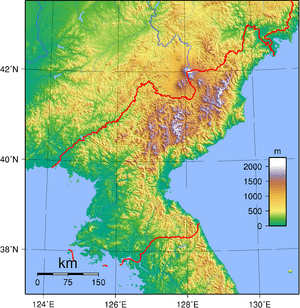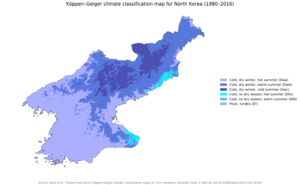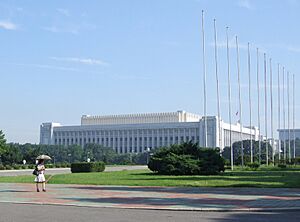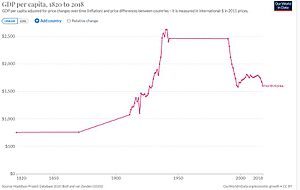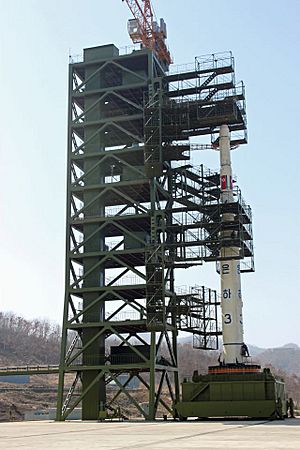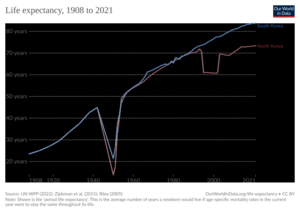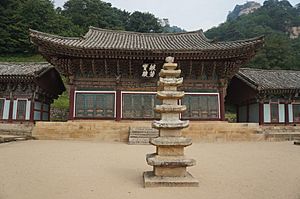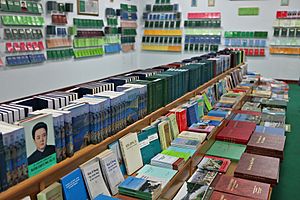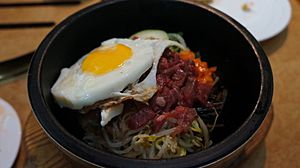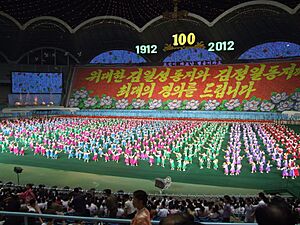North Korea
Quick facts for kids
Democratic People's Republic of Korea
|
|
|---|---|
|
|
|
|
National ideology:
Juche |
|
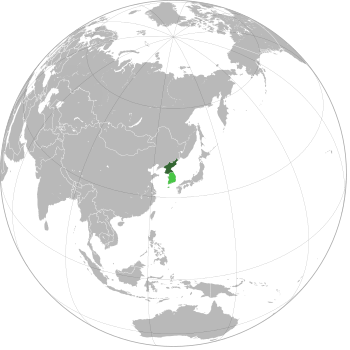
Territory controlled Territory claimed but not controlled (South Korea)
|
|
| Capital and largest city
|
Pyongyang 39°2′N 125°45′E / 39.033°N 125.750°E |
| Official languages | Korean (Munhwaŏ) |
| Official script | Chosŏn'gŭl |
| Religion
(2020)
|
|
| Demonym(s) |
|
| Government | Unitary one-party socialist republic under a totalitarian hereditary dictatorship |
| Kim Jong Un | |
|
• Premier
|
Kim Tok Hun |
|
• SPA Standing Committee Chairman and First Vice President
|
Choe Ryong-hae |
| Legislature | Supreme People's Assembly |
| Establishment history | |
|
• Gojoseon
|
2333 BC (mythological) |
| 57 BC | |
| 668 | |
| 918 | |
| 17 July 1392 | |
| 12 October 1897 | |
| 22 August 1910 | |
|
• Independence from Japan declared
|
1 March 1919 |
| 2 September 1945 | |
|
• People's Republic of Korea
|
6 September 1945 |
|
• Soviet administration north of the 38th parallel
|
3 October 1945 |
|
• 1st provisional govt.
|
8 February 1946 |
|
• 2nd provisional govt.
|
22 February 1947 |
|
• DPRK established
|
9 September 1948 |
| 27 December 1972 | |
| Area | |
|
• Total
|
120,538 km2 (46,540 sq mi) (98th) |
|
• Water (%)
|
0.11 |
| Population | |
|
• 2024 estimate
|
|
|
• 2008 census
|
|
|
• Density
|
212/km2 (549.1/sq mi) (45th) |
| GDP (PPP) | 2015 estimate |
|
• Total
|
$40 billion |
|
• Per capita
|
$1,800 |
| GDP (nominal) | 2019 estimate |
|
• Total
|
$16 billion |
|
• Per capita
|
$640 |
| Currency | Korean People's won (₩) (KPW) |
| Time zone | UTC+9 (Pyongyang Time) |
| Date format |
|
| Driving side | right |
| Calling code | +850 |
| ISO 3166 code | KP |
| Internet TLD | .kp |
North Korea, officially called the Democratic People's Republic of Korea (DPRK), is a country in the northern part of the Korean Peninsula. It shares borders with China, Russia, and South Korea. The capital and largest city is Pyŏngyang.
North Korea was created in 1948 after being freed from Japanese rule. A socialist state, supported by the Soviet Union, was set up. The southern part, the Republic of Korea, was supported by the United States. The U.S. helped create a democracy there.
A war, called the Korean War, broke out between the North and South in 1950. The fighting stopped in 1953, but the war never officially ended. North Korea became friends with China and Russia. Over time, it became more isolated.
North Korea's government is based on socialist ideas. This means that workplaces are mostly public property. The country's founder, Kim Il-sung, created his own idea called "Juche" (meaning "self-reliance"). This idea became very important in North Korea.
After Kim Il-sung died in the 1990s, his son Kim Jong-il became the leader. He started a "Songun" or "military-first" policy. This made the country focus a lot on its military. When he died in 2011, his youngest son Kim Jong-un took over. He leads North Korea today.
Contents
History of North Korea
Early Korean History
Historians believe that the Korean people have lived in this area for thousands of years. Before 1910, Korea was one country with a king. Most people were farmers, and it was a peaceful place.
In 1910, Japan took control of Korea. This happened after Japan and Russia went to war. Korea became a part of Japan.
Korea Becomes Divided
Korea was part of Japan from 1910 until World War II ended in 1945. After Japan surrendered, the USSR took control of the northern half of Korea. The United States took control of the southern half.
Each side then set up a government that matched their own ideas. The North became a communist state. The South became a democratic and capitalist state.
The Korean War Begins
In 1950, North Korea sent its soldiers into South Korea. North Korea wanted to unite the two Koreas into one communist country. They also wanted families that had been separated to be together again.
The United Nations sent soldiers from many countries to help South Korea. These countries did not like communism. They worried that if South Korea became communist, other countries might too. General Douglas MacArthur led these soldiers.
North Korea had taken over much of South Korea. With help from the United Nations, South Korea took back its land. They even pushed into North Korea, reaching the Yalu River, which is the border with China. China, which was also communist, then helped North Korea push back the South Korean soldiers.
After three years, in 1953, both sides agreed that no one would win the war. They signed an armistice, which is an agreement to stop fighting. North and South Korea were divided by a demilitarized zone (DMZ). This is a special area around the border where both countries cannot have many soldiers. This helps prevent new fighting.
North Korea in Modern Times
Even with the DMZ, there are sometimes small conflicts between soldiers on both sides. A special town in the zone, Panmunjom, is called the Joint Security Area (JSA).
In January 2021, Kim Jong Un was officially chosen as the General Secretary. This title was previously held by his father, Kim Jong Il. In September 2022, North Korea passed a law declaring itself a nuclear state.
In December 2023, Kim Jong Un said that South Korea was a "colonial vassal state." He also stated that if there was a war, North Korea would try to take over all of South Korea.
North Korean Geography
North Korea is in the northern part of the Korean Peninsula. It is located between 37° and 43°N latitude, and 124° and 131°E longitude. The country covers about 120,540 square kilometers (46,541 square miles). To the west are the Yellow Sea and Korea Bay. To the east is Japan, across the Sea of Japan.
Many visitors to Korea said the country looked like "a sea in a heavy gale." This is because of the many mountain ranges that cross the peninsula. About 80 percent of North Korea is made up of mountains and uplands. These are separated by deep, narrow valleys.
All of the Korean Peninsula's mountains that are 2,000 meters (6,560 feet) or taller are in North Korea. The highest point is Paektu Mountain, a volcanic mountain. It is 2,744 meters (9,003 feet) above sea level. North Koreans consider Mount Paektu a sacred place. It is important in Korean culture and in stories about the Kim family.
The coastal plains are wide in the west but broken up in the east. Most of the people live in these plains and lowlands. Forests cover over 70 percent of the country, mostly on steep slopes. The longest river is the Amnok (Yalu) River, which flows for 790 kilometers (490 miles).
North Korea's Climate
North Korea has a humid continental climate. Winters are clear and often have snow storms. These come from northern and northwestern winds blowing from Siberia. Summer is usually the hottest, most humid, and rainiest time of year. This is because of southern and southeastern monsoon winds. These winds bring moist air from the Pacific Ocean. About 60 percent of all rain falls from June to September. Spring and autumn are seasons that transition between summer and winter.
Government and Politics
North Korea is a very centralized country. It is a one-party totalitarian government. This means one political party has complete control, and the government controls almost all parts of people's lives.
Kim Jong Un from the Kim family is the current Supreme Leader of North Korea. He leads all the main government groups. He is the general secretary of the Workers' Party of Korea and president of the State Affairs. His grandfather, Kim Il Sung, was the founder and leader until he died in 1994. He is called the country's "eternal President". His father, Kim Jong Il, was called "Eternal General Secretary" after he died in 2011.
The constitution says there are three main parts of the government. The first is the State Affairs Commission (SAC). This group makes big decisions about the country's defense and follows Kim Jong Un's directions. It also oversees the military and security ministries.
The Supreme People's Assembly (SPA) holds the power to make laws. Its 687 members are chosen every five years by universal suffrage, meaning all adults can vote.
The Cabinet of North Korea holds the power to carry out laws. It is led by the Premier.
North Korean Military

North Korea's armed forces are called the Korean People's Army (KPA). It is one of the largest military forces in the world. It has about 1,280,000 active soldiers and 6,300,000 reserve and paramilitary troops. About 20 percent of men aged 17–54 serve in the regular military. This means about one in every 25 citizens is a soldier.
The KPA has five main parts:
- Ground Force
- Navy
- Air and Anti-Air Force
- Special Operations Force
- Rocket Force
The Ground Force is the largest part. It has about one million soldiers. The Air Force has around 1,600 aircraft. The Navy has about 800 ships, including the world's largest submarine fleet. North Korea's Special Operation Force is also the largest special forces unit in the world.
North Korea is a nuclear-armed state. This means it has nuclear weapons, though how many and how strong they are is not fully known. The United Nations has placed rules on other countries not to sell weapons to North Korea.
The U.S. State Department says North Korea spent about 23% of its country's money on its military from 2004 to 2014. This was the highest level in the world.
North Korean Economy

North Korea has one of the most closed economies in the world. Since the 1940s, it has tried to be self-sufficient. Support from the Soviet Union and China helped North Korea recover quickly after the Korean War. However, the economy started to slow down around 1960. It faced shortages of skilled workers, energy, and good land.
This slowdown was very different from South Korea, which grew much faster. By the 1980s, South Korea had a larger economy. North Korea stopped announcing its economic plans after 1993.
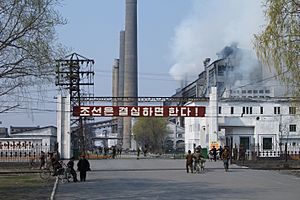
In the 1990s, North Korea lost its main trading partners. It also faced many natural disasters. This led to very difficult times, including a widespread food shortage. By 2000, things got better with a lot of international food help. But the economy still has food shortages, old buildings, and not enough energy.
The government tried to make changes in 1998. They allowed some private ownership and more local control over production. More changes in 2002 allowed more market activities. However, North Korea is still a command economy. This means the government owns almost everything and decides what is produced.
North Korea's economy is heavily controlled by the government. Food and housing are largely provided by the state. Education and healthcare are free. People officially stopped paying taxes in 1974. There are stores in Pyongyang, but most people rely on small markets called jangmadang.
Industry and services employ 65% of North Korea's workers. Major industries include making machines, military equipment, and chemicals. Mining, metal production, and textiles are also important. Iron ore and coal production are areas where North Korea does better than South Korea. It produces about 10 times more of these resources.
The farming sector was badly hurt by the disasters of the 1990s. Farms now often lack fertilizer and equipment. Rice, corn, soybeans, and potatoes are key crops. Fishing and aquaculture also provide a lot of food. Tourism has been growing. North Korea wants to attract more foreign visitors with projects like the Masikryong Ski Resort. In January 2020, North Korea closed its borders to tourists because of the COVID-19 pandemic in North Korea.
China is North Korea's biggest trading partner. In 2014, Russia canceled 90% of North Korea's debt. The two countries agreed to trade using Russian money.
Transportation in North Korea
North Korea has railways, roads, water, and air routes. Trains are the most common way to travel. Railways cover about 5,200 kilometers (3,230 miles). They carry 80% of passengers and 86% of goods each year. However, electricity shortages make them less efficient.
Road travel is very limited. Only 724 kilometers (450 miles) of the 25,554 kilometers (15,879 miles) of roads are paved. Most roads are not well kept. Cars are rare, but bicycles are common. There is only one international airport in Pyongyang.
Energy in North Korea

North Korea's energy system is old and in bad shape. Power shortages happen often. Coal provides 70% of the country's energy. Hydroelectric power provides 17%. The government wants to use more renewable energy, like wind and solar power. They hope to produce 5 million kilowatts from renewable sources by 2044.
North Korea also wants to develop its own nuclear power. But other countries are concerned about this because it could be used for military purposes.
Science and Technology
Research and development (R&D) is done at the State Academy of Sciences. This academy has 40 research centers and other facilities. The government believes science and technology are directly linked to how the economy grows.
North Korea has put a lot of effort into its space program. It launches its own rockets and satellites from two spaceports. After several tries, North Korea became the tenth spacefaring nation in December 2012. This was when Kwangmyŏngsŏng-3 Unit 2 successfully reached orbit. The government says its space program is for peaceful uses. However, other countries believe it helps North Korea's missile program.
The use of communication technology is controlled by the government. There is a nationwide fiber-optic telephone system. Mobile phone use is growing. However, international calls are limited. Mobile Internet is not available.
Internet access is only for a few special users and scientists. Instead, North Korea has a special internal network called Kwangmyong. This network is watched by the government. It only has state media, chat, message boards, email, and a few thousand websites.
North Korean People
North Korea's population was 10.9 million in 1961. Except for a small Chinese community and a few Japanese, North Korea's people are all from the same ethnic group. Experts thought the population would grow to 28 million by 2010. However, this did not happen because of the North Korean famine. This food shortage began in 1995 and lasted for three years. It caused many deaths.
Language in North Korea
North Korea shares the Korean language with South Korea. However, there are some differences in how they speak.
Religion in North Korea
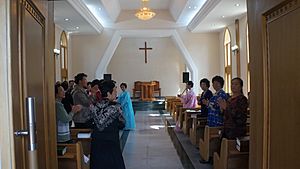
North Korea is officially an atheist state. This means the government does not support any religion. Its constitution says people have freedom of religion. But this freedom is limited. Religion cannot be used to harm the state or change the social order. So, religious practice is restricted.
Education in North Korea

The 2008 census said that everyone in North Korea could read and write. There is 11 years of free, required education. This includes nursery schools, kindergartens, primary schools, and secondary schools. Many universities and colleges offer higher education.
Most students finish school and then go into military service or work on farms or in factories. Higher education focuses a lot on government ideas. The study of science is very important, while social studies are less so. Learning Russian and English became required in middle schools in 1978.
North Korean Culture
Korean culture has its own unique identity. It was attacked during Japanese rule from 1910 to 1945. During this time, Koreans were forced to learn Japanese and use Japanese names. They were not allowed to speak or write Korean in public.
After Korea was divided in 1945, two different cultures grew from the shared Korean heritage. North Koreans have little contact with foreign influences. Art often focuses on the country's history and its leaders. Old cultural elements that were seen as "bad" were removed. New cultural forms with a "folk" spirit were brought back.
The state protects and maintains Korean heritage. Over 190 historical sites are listed as National Treasures of North Korea. The Historic Monuments and Sites in Kaesong and the Complex of Koguryo Tombs are UNESCO World Heritage Sites. These ancient tombs have clear murals and show how Goguryeo culture influenced other Asian civilizations.
Art in North Korea
Visual arts in North Korea usually follow the style of socialist realism. This means art is used to show loyalty to the government. All artists must join the Artists' Union. The best artists can get a special license to draw the leaders. Pictures and statues of Kim Il Sung, Kim Jong Il, and Kim Jong Un are called "Number One works."
The Mansudae Art Studio is very important for art in North Korea. It was started in 1959. It employs about 1,000 artists. They create paintings, murals, posters, and monuments. The studio also sells its art to collectors in other countries, like China. A part of the studio, Mansudae Overseas Projects, builds large monuments for international customers.
Literature in North Korea
All publishing houses are owned by the government. They are seen as important tools for spreading government ideas. The Workers' Party of Korea Publishing House publishes all the works of Kim Il Sung and party policy documents. There are not many foreign books available. Some examples include fairy tales and the Harry Potter books.
Kim Il Sung's own writings are considered "classical masterpieces." Books written under his guidance are called "models of Juche literature." These include historical novels about Koreans suffering under Japanese rule. Most books published are about political topics, like "army-first revolutionary literature."
Science fiction is a less common type of book. It allows authors more freedom to write about topics like cyberwarfare, violence, and crime. These topics are usually not in other types of books. Science fiction stories often praise technology. They also promote the Juche idea of humans being the center of everything.
Music in North Korea
The government has focused on happy folk songs and revolutionary music. Songs often share government ideas. Large orchestral pieces, like the "Five Great Revolutionary Operas," are based on traditional Korean music. These operas are different from Western ones. They add traditional instruments and do not have spoken parts. Sea of Blood is the most popular of these operas.
Pop music started in the 1980s with groups like the Pochonbo Electronic Ensemble. After better relations with South Korea in 2000, pop songs had fewer direct political messages. But themes like friendship and building a strong country remained. The all-girl Moranbong Band was very popular in 2014. North Koreans also listen to K-pop from South Korea, which spreads through unofficial markets.
Media in North Korea
Government rules for film are similar to those for other arts. Movies are meant to help with "social education." Some popular films are based on historical events or folk tales. Most movies have predictable stories that promote government ideas. This makes cinema not very popular. Viewers only watch films with their favorite actors. Western movies are usually only shown privately to high-ranking officials. However, the 1997 film Titanic is often shown to university students as an example of Western culture.
Cuisine in North Korea
Korean food has changed over many years. It comes from ancient farming and nomadic traditions. Rice dishes and kimchi are basic Korean foods. In a traditional meal, they are eaten with side dishes (panch'an) and main courses like juk or noodles. Soju is a well-known traditional Korean drink.
North Korea's most famous restaurant is Okryu-gwan in Pyongyang. It is known for its raengmyeon (cold noodles). Other dishes include fish soup with rice and beef rib soup. Okryu-gwan sends teams to the countryside to find new recipes. Some Asian cities have branches of the Pyongyang restaurant chain. There, waitresses perform music and dance.
Sports in North Korea
Most schools have daily practice in soccer, basketball, table tennis, gymnastics, and boxing. The DPR Korea League is popular in the country, and its games are often shown on TV. The national soccer team, Chollima, played in the FIFA World Cup in 2010. They lost all three matches. Their 1966 appearance was more successful. They had a surprise win against Italy and reached the quarter-finals.
North Korea's first appearance in the Olympics was in 1964. At the 1972 Olympics, they won five medals, including one gold. North Korean athletes have won medals in all summer games since then, except for the boycotted Los Angeles and Seoul Olympics. Successful Olympians receive fancy apartments from the state for their achievements.
The Arirang Mass Games is recognized as the biggest dance event in the world by Guinness World Records. About 100,000 athletes perform gymnastics and dances. Another 40,000 people create a huge moving screen in the background. The event shows the country's history and honors Kim Il Sung and Kim Jong Il. The Rungrado 1st of May Stadium, the largest stadium in the world, hosts the festival. The Pyongyang Marathon is another notable sports event. Amateur runners from around the world can take part in it.
Images for kids
-
Kim Il-sung, the founder of North Korea
-
Satellite image of the Korean Peninsula at night, showing the difference in lighting between North and South Korea.
See also
 In Spanish: Corea del Norte para niños
In Spanish: Corea del Norte para niños




